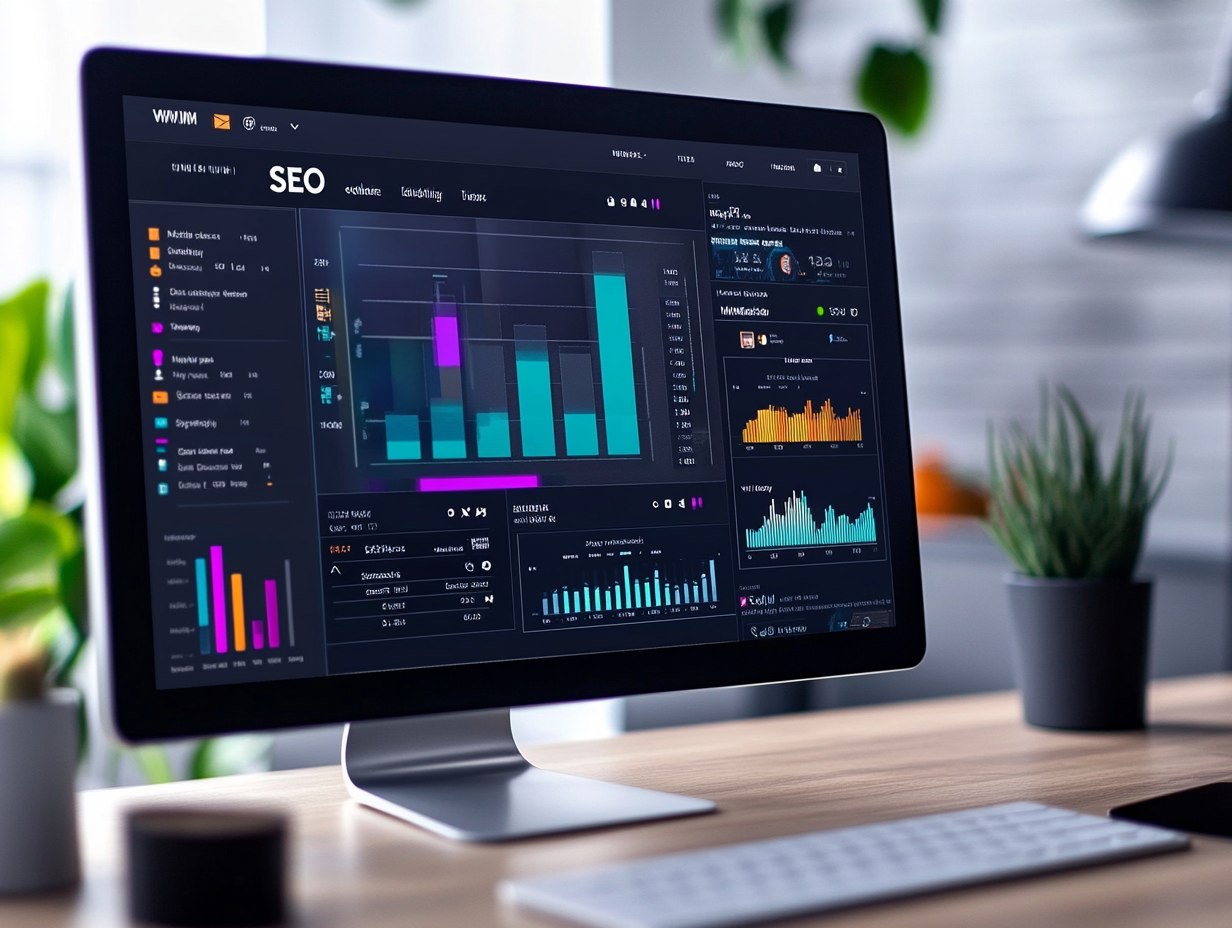Content optimization
THE content optimization is one of the most important factors that determines the search engine optimization (SEO) success of your website. The quality, structure, and techniques of your content have a direct impact on how Google and other search engines rank your site. The long-form content, the multimedia elements, as well as the internal linking they all play a key role in your website's SEO performance.
Long-form content
Why is writing long, detailed articles important for SEO?
Long, detailed articles are becoming increasingly important in search engine optimization, as Google and other search engines favor sites that provide comprehensive, informative answers to user queries. Research also shows that articles of more than 2000 words They are more often among the first results in Google because they are more detailed and cover the search topic better.
Long-form articles give you the opportunity to delve deeper into a topic, use more keywords, and provide in-depth answers to users’ questions. Google’s algorithms, especially BERT (Bidirectional Encoder Representations from Transformers) model, are able to understand long-form articles better and take relevance into account more than shorter content.
Example: If a website SEO-related article If you write an article that covers everything from the term “SEO Basics,” then the long article will likely answer several different questions, such as: “Why is SEO important?”, “How to do keyword research?”, “What is link building?. This will help your article reach a wider audience and rank higher in search results.
How to achieve the best SEO results with long articles on WordPress?
-
Creating detailed, valuable content: The key is to provide real value to your visitors. For long articles, it’s especially important to make sure your content is informative and well-researched. Use expert sources, statistics, examples, and research to back up your content.
-
Subheadings and sections: Long articles can be easily readable if you break them up properly with subtitles (H2, H3, etc.). This not only improves the user experience, but also helps Google understand the structure of the article. Subheadings can also contain keywords, thereby strengthening SEO.
-
Text links and internal linking: Since long articles contain a lot of information, it is worth internal links that link to other relevant pages within the website. This helps search engines understand how each page is related to each other and also helps users navigate.
-
Update and maintenance: Long articles should be updated with new information from time to time to keep them current. Google favors pages that are constantly adding new, relevant content.
Multimedia content
How do we optimize images and videos?
THE multimedia content, such as images, videos, and infographics, can significantly improve the user experience, but optimizing them properly is key for SEO. Optimization helps your website load quickly and helps search engines better understand your content.
-
Optimizing images: Reducing the size of images is extremely important for website speed. If an image is too large, it can slow down the page loading, which negatively affects user experience and SEO. Use image compression tools such as Smush or WP Compressto reduce file size without significantly degrading image quality.
-
Alt texts: Add to each image alt text, which describes the image and includes the keyword if possible. Alt text helps search engines understand what the image is about and improves SEO, especially for image searches.
-
Optimize videos: Videos are also an extremely popular form of content, but if they are not optimized, they can slow down your website. One of the best solutions is to not upload videos directly to the site, but to use platforms like YouTube or the Vimeo embed them using . This not only improves speed, but can also help your videos perform better on search engines. Such for type of videos It is also important to provide well-written descriptions and titles that are relevant and keyword-friendly.
How do we ensure that videos don't slow down the website?
-
Embedding videos from external platforms: Instead of uploading videos directly to your WordPress server, use an external video sharing platforms like YouTube or Vimeo. This helps avoid website slowdowns as videos are handled by other servers.
-
Applying lazy loading: Use lazy loading technique that allows videos to load only when the user scrolls to that part of the page. This speeds up page loading, especially when there are multiple videos on a page.
Internal linking
How to use internal links on your WordPress pages for better SEO?
THE internal linking is the practice of placing links to other pages or posts within a website. Internal links help visitors navigate the website more easily and help search engines better understand the structure of the page.
-
Placement of relevant links: It's important to always keep internal links relevant to your content. For example, if you're writing a blog post about SEO, you might want to include an internal link to another article about keyword research.
-
Linking in the page hierarchy: Go to the most important pages, such as the home page or broader topics processing pages, it is worth placing more internal links. This helps search engines assign priorities to individual pages.
Why is it important to place relevant internal links?
Placing relevant internal links not only improves the user experience, but is also important for SEO. Internal links help search engines to rank pages, and help make all of your site's content more visible to search engines. Additionally, internal links contribute to content relevance and the website in general authoritarian to increase its status.
Content optimization is key to WordPress SEO. Long-form articles, well-optimized multimedia content, and effective internal linking all contribute to improving your website’s search engine optimization. By implementing the tips mentioned above, you can ensure that your content is valuable and easy to consume not only for Google but also for your visitors, thus increasing your organic traffic and the success of your website.
Mobile-friendly website and responsive design
THE mobile friendly website and the responsive design play a fundamental role in modern SEO. Since the mobile The use of mobile devices while browsing the internet has increased dramatically in recent years, and Google and other search engines are paying increasing attention to mobile-optimized websites. For a website to be successful in its SEO strategy, it is essential that visitors can enjoy a good user experience on different devices (mobile, tablet, desktop).
Why is mobile optimization important for SEO?
THE mobile optimization is not only important for improving user experience, but also has a direct impact on SEO performance. Smart phones and tablets With the spread of the Internet, users are increasingly are browsing from mobile devices, and according to statistics, more than users 50%-a searches on mobile devices. In 2023, global web traffic 58%-a on mobile devices (Source: Statista).
THE mobile optimization helps ensure that your website displays quickly and well on mobile devices, improving user experience and SEO rankings. Google, as the world's largest search engine, has been implementing mobile-friendly features since 2015. mobile-friendly algorithm, which prioritizes websites that are mobile-friendly.
The impact of Google's mobile-friendly algorithm
THE Google's mobile-friendly algorithm Since its introduction, Google has taken into account how a website appears on mobile devices when ranking pages. This means that if a website is not optimized for mobile devices, Google will likely give it a lower ranking in search results, even if the desktop version is excellent.
Google introduced in 2020 Mobile-First Indexing rule, which means that the search engine now uses the mobile version of the website first to rank the page, rather than the desktop version. This makes it even more important that the website works well not only on desktop but also on mobile.
How can we ensure that our WordPress website is mobile friendly?
Making WordPress websites mobile-friendly is not a complicated task, but there are a few important steps you should take to ensure your website looks good on all devices.
-
Use responsive design: THE responsive design allows the website to automatically adapt to different screen sizes. This ensures that the website looks good and is easy to navigate on all devices. Most modern WordPress theme It is optimized for responsive design and can adapt the website to different screen sizes.
-
Optimize page loading speed: THE on mobile devices Fast loading speeds are key, as internet connections are often slower than on desktops. Google pays close attention to website speed, and slow sites can be at a disadvantage in ranking. Use image compression tools (such as Smush or WP Compress) to optimize images and implement cache extensions, such as WP Rocket for faster loading speed.
-
Test the mobile version: Google provides the Mobile-Friendly Test tool to check how your website performs on mobile devices. If the test results do not meet the desired mobile-friendly criteria, it is worth making changes to the design or structure of the page.
-
Minimize pop-up windows: Appears on mobile devices pop-up windows They can be distracting, making navigation difficult and reducing the user experience. Google specifically penalizes sites that display excessively large pop-ups on mobile devices. Try to use discreet, smaller pop-ups that don't interfere with users.
Responsive themes and templates
THE responsive theme means that the website automatically adapts to different screen sizes, ensuring that visitors always get an optimized user experience no matter what device they are using. WordPress offers a lot of responsive templates that can be used to easily create a mobile-friendly website.
The best responsive WordPress templates and themes
-
Astra: Astra is a hugely popular, fast and responsive WordPress theme. It has excellent SEO optimization and is highly customizable, making it an ideal choice for any type of website.
-
GeneratePress: GeneratePress is another lightweight and responsive WordPress theme that offers excellent speed and an SEO-friendly design. Fast loading times are especially important if you want a mobile-optimized site.
-
OceanWP: OceanWP is a feature-rich theme that is fully responsive and highly customizable. OceanWP can be a great choice if you want to create a visually stunning website with a mobile-friendly design.
Why choose a template that is mobile-friendly by default?
Using mobile-friendly templates is extremely important, as they ensure that your website looks good and performs optimally on all devices. Templates that are mobile-friendly by default save you from having to manually build a responsive design, which can be a time-consuming and complicated task if you don't have enough experience in web development.
Additionally, mobile-friendly templates often already include optimized features such as fast loading times, proper navigation menus, and easy-to-read fonts that help improve the user experience.
Mobile optimization and responsive design are key to making your website rank well in search engines. Since Google is the Mobile-First Indexingis used, optimization is essential to achieve high rankings. WordPress has a number of mobile-friendly templates and tools that help you quickly and easily optimize for mobile, so you can ensure that your website works great and loads quickly on all devices.
Loading speed optimization
THE website loading speed is not only important for improving the user experience, but also a fundamental factor for SEO. Google and other search engines are increasingly taking website speed into account, and faster sites have a ranking advantage. Slow sites can not only result in visitor abandonment, but also have a direct impact on the ranking given by search engines.
Why is fast page loading important for SEO?
THE loading speed is a key factor, as user experience is directly related to website speed. The Google It has officially taken website speed into account in its ranking since 2010. Pages that load quickly not only provide a better user experience, but also receive an advantage in search engine results. The Google PageSpeed Insights According to, if a page takes longer than 3 seconds to load, it 50% It gives visitors a chance to leave the website. This not only reduces the number of users, but also negatively affects SEO performance.
Further research also shows that website speed has an impact on for conversions. One Google Statistics show that for mobile websites, where loading time increased by 1 second, conversions decreased by 20%. This is especially important for e-commerce websites and businesses, as slow pages can deter customers.
Google PageSpeed and the impact of website speed on SEO
THE Google PageSpeed Insights is a tool that measures website speed and provides suggestions for improving performance. Google also Core Web Vitalsalso takes into account when ranking, which relate to page loading speed, interaction latency, and visual stability. Fast pages not only rank better in search engines, but also mobile searches and the computer searches both receive advantageous positions.
Google PageSpeed Insights measures the following basic metrics:
-
Largest Contentful Paint (LCP): The largest content that is optimal for a load time of 2.5 seconds or less.
-
First Input Delay (FID): Response time to first interaction. If it is under 100 ms, it is ideal.
-
Cumulative Layout Shift (CLS): Visual stability, which should remain below 0.1 for a smooth user experience.
Fast page loading is therefore not only important for users, but also in SEO rankings also plays a prominent role. Slow sites tend to lose visitors, and bounce rate (bounce rate) can directly reduce search engine rankings.
How to measure and improve WordPress website loading speed?
THE WordPress There are several tools you can use to measure and improve the speed of your web pages. The following steps can help you optimize your speed:
-
Google PageSpeed Insights: One of the easiest and best tools to test your page loading speed. It gives you a comprehensive report on your page and makes suggestions for improvements.
-
GTMetrix: This tool provides detailed information about your website speed and helps you understand what is causing the slowdown. It also provides recommendations such as image optimization and cache settings.
-
Pingdom: Another useful tool for measuring website performance, it provides a clear and easy-to-understand report on loading times.
Recommended steps to improve speed:
-
Compressing files: Compressing file formats like CSS, JavaScript, and HTML reduces file size, thereby speeding up loading.
-
Using cache: THE cache-ing helps store static files in browsers, making the page load faster for visitors.
-
Minimum HTTP requests: Each element (such as images, CSS files, JavaScript) generates a separate HTTP request. Reducing the number of such requests can speed up the page.
Speed optimization tools
Some of the top speed optimization plugins that can help you improve the performance of your WordPress website are:
-
WP Rocket: One of the best speed optimization plugins that can automatically speed up your website by handling caching, image compression, and file minification. WP Rocket is easy to use and will result in significant speed increases on most WordPress websites.
-
W3 Total Cache: This plugin offers a number of settings to increase website speed, such as browser caching, CDN support, and minification. There is a free version available, but the premium version offers more advanced settings.
-
Autooptimize: The Autoptimize plugin helps you optimize your HTML, CSS, and JavaScript files. The basic features are available for free and can result in significant improvements in loading speed.
How can we reduce the size of images and use a CDN?
Optimizing images is essential to increasing website speed. Image files that are too large will slow down page loading, especially on mobile devices.
-
Using image optimization plugins: Plugins like Smush or ShortPixel, allow you to compress images without losing image quality. The Smush plugin, for example, automatically compresses images when they are uploaded, helping your website load faster.
-
Using a CDN (Content Delivery Network): CDNs help to serve your website content from different servers in different parts of the world. This reduces loading times because visitors download the content from the server that is geographically closest to them. The Cloudflare and the KeyCDN two popular CDN providers that can be easily integrated into WordPress websites.
THE website speed is a fundamental factor in SEO success. Fast pages not only provide a better user experience, but also benefit search engine rankings. The Google PageSpeed Insights, the WP Rocket, the W3 Total Cache and other tools help measure and improve website performanceAdditionally, optimizing images and using a CDN can go a long way toward faster loading times. By implementing these strategies, you can ensure that your website is not only fast, but also search engine friendly.
SEO analytics and tracking
THE SEO analytics and the tracking are essential parts of any successful SEO strategy. Without measuring and monitoring key metrics, we can’t know how effective our strategies are and where improvements are needed. The Google Analytics and the Google Search Console two tools that can help you get detailed information about your website's performance and help you achieve the best SEO results.
Integrating Google Analytics and Search Console
Why is it important to use Google Analytics and Search Console?
-
Google Analytics: THE Google Analytics is an extremely useful tool that allows you to track website visitor behavior. You can measure organic traffic, user interactions, top pages, and many other important metrics that help you determine how your website is performing. One of its most important advantages is that it allows you to analyze sources (e.g. direct visitors, organic search, social media, etc.) so you can see how successful your SEO efforts are.
-
Google Search Console: THE Google Search Console helps you track the technical side of search engine optimization. With Search Console, you can see how your website is performing in Google search, what keywords it appears for, and what the most popular pages are. In addition, Search Console also reports errors and warnings, such as if a page failed to be indexed or if there are problems with the mobile-friendly design.
Both devices free and extremely important tracking your website's SEO strategy. The data helps you fine-tune your optimization by providing specific information about visitor behavior and search engine rankings.
How can we connect our WordPress site with these tools?
Connecting Google Analytics and Google Search Console to your WordPress site is a quick and easy process.
-
Google Analytics integration:
-
First, sign up for Google Analytics if you haven't already.
-
Create a new one Google Analytics accountand generate a tracking code.
-
Add the tracking code to your WordPress site. You can do this manually by pasting the code into your HTML code, or you can use a plugin, such as MonsterInsights or the Google Analytics Dashboard for WP.
-
Google Search Console integration:
-
Sign up for Google Search Console and add the website to your account.
-
To verify the website owner in Search Console, you need a HTML file or meta tag to your website. The easier way is to use a plugin, such as Yoast SEO or the RankMath, which automatically integrate Search Console with your WordPress site.
Once you've linked your accounts, you can start tracking analytics and ranking performance.
Monitoring search engine optimization through SEO plugins
How to monitor SEO performance using Yoast SEO or RankMath?
THE Yoast SEO and the RankMath Both plugins are extremely useful for monitoring SEO performance and provide detailed statistics on your website's performance. These plugins not only manage SEO settings, but also alert you to optimal keyword usage and provide suggestions for improving your content.
-
Yoast SEO: Yoast SEO plugin built-in SEO analysis provides for every page and post. It shows you how well you are using keywords, what needs improvement, and how you can optimize your content even more. The during analysis They also pay attention to meta descriptions, keyword density, subheadings, and readability.
How can we monitor SEO performance?
-
RankMath: The RankMath plugin also has a built-in SEO performance monitoring tool. You can see which keywords are performing well and which ones need to be refined in its analytics panel. RankMath continuously monitors your SEO keywords and keeps you up to date with ranking changes. The plugin also integrates with Google Search Console, so Search Console data is available directly in the RankMath dashboard.
Important metrics to watch: organic traffic, keyword rankings, page loading speed
To track SEO performance, you need to monitor the following metrics:
-
Organic traffic: Organic traffic is the most important metric that shows how many visitors came from search engines, such as Google. You can measure this metric using Google Analytics and use different filters, such as sources you can analyze it according to.
-
Keyword ranking: Keyword ranking shows how your website ranks in search engine results. You can track this with Google Search Console and RankMath, where you can find your keyword rankings, search volume, and clicks. It's important to constantly monitor which keywords are performing well and which ones need improvement.
-
Page loading speed: Page speed has a direct impact on SEO and you can measure this with Google PageSpeed Insights. WordPress website speed can be easily improved by using the right plugins and techniques (e.g. caching, image compression).
THE SEO analytics and tracking is key to continuously optimizing your website performance and search engine rankings. Google Analytics and the Google Search Console By integrating it, we can provide detailed information about how our website is performing and which areas need improvement. SEO plugins like Yoast SEO and the RankMath, while they help you continuously monitor your keywords and SEO settings. Key metrics like organic traffic, keyword rankings, and website speed all contribute to SEO success, so monitoring them is essential.
Link building and external SEO factors
THE link building and the external SEO factors are crucial to any successful SEO strategy, especially WordPress for websites. Link building, especially external links (backlinks) Getting links plays a fundamental role in a website's ranking, as search engines like Google consider them one of their most important ranking factors. External links pointing to other high-quality websites signal to search engines that your website is a valuable, relevant, and authoritative resource.
The Importance of Link Building in WordPress SEO
THE link building is one of the most important aspects of SEO, as backlinks are the Google's algorithm one of the central ranking factors. External links help increase the page's authenticity and authoritarian statusThe more high-quality, relevant pages that link to your website, the more likely it is that search engines will rank your site higher.
THE backlinks They are not only beneficial for search engines, but also for users. Having a well-known website linking to yours can bring in new visitors and potentially increase conversions.
Why are external links (backlinks) important?
External links on the website for authentication serve. The Google and other search engines backlinks to websites popularity and reliability A well-chosen external link increases the page's expert status, which can contribute to better rankings.
THE Google's PageRank algorithm The number and quality of backlinks is also based on it. The more relevant and reliable sources link to your website, the more you can indicate that your page is important and contains valuable information.
How can we build organic links to our website?
The organic link building collecting links in a natural way that is not manipulative and provides real value to users. Building organic links takes time, but it is one of the most prudent and effective ways to improve your website's SEO. Some important strategies for organic link building:
-
Creating quality content: One of the best ways to get organic links is to valuable, informative and interesting content You create content that is worth sharing with others. Blog posts, research papers, case studies, infographics, and tutorials are all types of content that easily attract links.
-
Guest blogging: Guest blogging involves publishing content on other websites and linking back to your own website in the articles. This not only provides backlinks, but also allows you to reach a new audience. It is important to choose relevant and authoritative websites that already have good search engine rankings.
-
Find link building partners: You can look for companies, bloggers, or influencers who are willing to link to your website. Link exchanges and collaborations can be useful if your partners are trustworthy and relevant within your industry.
-
Social media and forums: Social media platforms and forums also offer opportunities to gain organic links. The Reddit, the Quora or the LinkedIn When used properly, references to professional articles can also bring valuable backlinks.
The impact of social media on SEO
Although the social media your links don't count directly for backlinks For Google, an active social media presence has a significant indirect impact on SEO. Social platforms can help increase a site’s visibility and traffic, which can ultimately contribute to better rankings.
-
Increases traffic: If content is shared on social media, it can bring new visitors to your website. If visitors find your content valuable, then of course there is a chance that other websites will link to it.
-
Strengthens brand credibility: Active presence on social media and expert status Getting it can help others link to your website. People tend to share links to websites that are trustworthy and contain valuable information.
-
Search engine attention: Google does not use social media signals as a direct ranking factor, but active participation in social media can increase your website credibility and social proof, which positively affects the ranking.
How can social media platforms support SEO?
Social media platforms can indirectly help SEO by increasing website visibility and traffic. Social media provides an opportunity to share your content, draw attention to yourself for a new blog post or promote a new product that will attract more visitors.
-
Facebook: Although Facebook links are not directly important for SEO, they can still help spread the word about your content. The more people share your content, the more people it will reach.
-
Instagram: Instagram does not allow you to place external links in posts, but links placed in your profile and using Instagram Stories can indirectly increase traffic to your website.
-
LinkedIn: LinkedIn is a professional social platform where companies and experts regularly share valuable content. Having an active presence on LinkedIn can help you reach a professional audience and increase your backlinks.
Should we use social media buttons on our WordPress pages?
The answer: Yes! Integrating social media buttons on your website can improve your SEO performance by giving visitors the ability to easily share your content. Social media buttons can help increase the reach of your content and potentially increase organic traffic. There are several ways to add social media buttons to your WordPress site. plugin available for integrating social media buttons, such as Social Snap, Sassy Social Share, or the Jetpack.
Social media buttons are not only important for SEO, but they also contribute to for user experience also, as they give visitors the opportunity to easily share your content on their own social networks.
THE link building and the external SEO factors play a key role in any successful SEO strategy, especially WordPress for websites. Proper use of external links and social media can help increase the credibility of a website and improve its ranking in search engine results. Link building should be organic and based on valuable, relevant content. Incorporating social media buttons can also help to reach a wider audience, which can indirectly improve SEO.
Summary and best tips
THE SEO (Search Engine Optimization) is a fundamental element of a website's success, and is especially important for WordPress for websites. With the right SEO strategy, you can not only improve your website's ranking in Google, but also attract more visitors, which ultimately increases conversions. Now let's take a look at the most important SEO tips that every On a WordPress website It is worth using to achieve the best results.
A quick summary of the most important SEO tips for your WordPress website
-
Use appropriate SEO plugins: THE Yoast SEO or the RankMath You can easily optimize your WordPress site with these plugins. These plugins automatically help you set meta titles, descriptions, keywords, and other SEO parameters.
-
Optimize your website loading speed: Fast page load times are not only important for improving user experience, but they also have a direct impact on SEO rankings. Use tools like Google PageSpeed Insightsand implement cache extensions (for example WP Rocket or W3 Total Cache) to optimize speed.
-
Keyword research and optimization: The foundation of any successful SEO strategy is finding the right keywords. Use keyword research tools like Google Keyword Planner, SEMrush or Ahrefsto find keywords that can drive high search traffic to your website. Don't forget to include keywords in your titles, URLs, and meta descriptions.
-
Mobile-friendly design: Since Google favors mobile-friendly sites, make sure your website is responsive. mobile-first indexing Due to this rule, Google ranks mobile versions first, so it's important that the mobile experience is seamless.
-
Quality content: Valuable, informative, and long-form content is one of the most important SEO factors. Google ranks pages that provide detailed answers to user questions better. The long-tail keywords Its use is especially important in niche markets.
-
Link building: External links (backlinks) help your website appear authoritative to search engines. It's worth getting links from websites that are related to your industry or topic and that already have high SEO authority.
-
Social media integration: Although social media links are not a direct SEO factor, social shares can help increase your website’s visibility and traffic. Incorporating social media buttons on your WordPress site allows visitors to easily share your content, which can help increase organic traffic.
The most common mistakes to avoid
-
Keyword stuffing: While keyword placement is important, excessive keyword stuffing can be harmful. Google’s algorithms can detect over-optimization and may penalize such websites. Always keep readability and a natural text experience in mind.
-
Not mobile-friendly design: If your website is not responsive, it is seriously detrimental to SEO, as Google ranks mobile versions first. A mobile-friendly design not only has a positive impact on SEO performance, but also on user experience.
-
Too much similar content: If you have multiple pieces of similar or duplicate content on your page, Google won't know which one to rank higher, and this can lower your page's ranking. Always make sure that the content on your page is unique and distinct.
-
Slow website: Slow websites not only degrade the user experience, but can also be a problem for search engines. Slow sites are ranked lower by Google, so be sure to optimize your page speed using the methods mentioned above.
-
Neglected metadata: THE meta titles and meta descriptions are extremely important for SEO. If you don't provide unique meta descriptions and titles, Google will automatically pick one from your content, which may not be properly optimized. Make sure Make sure every page and post has a unique and keyword-friendly meta description.
Tip: How to stay up to date with SEO trends?
The world of SEO is constantly changing, and to gain a competitive advantage, it's important to stay up to date with the latest trends. Here are some tips on how to stay up to date with the latest SEO developments:
-
Follow SEO experts and blogs: In the ever-changing world of SEO, it's worth learning from experts who share up-to-date information. Follow blogs like Movie, the Search Engine Journal, or the Neil Patel blog. These sites update SEO guidelines and latest developments daily.
-
Attend SEO webinars and conferences: Attending SEO industry events can help you understand the latest trends, algorithm updates, and SEO strategies. Such events include: SMX (Search Marketing Expo) or the MozCon.
-
Use SEO tools: THE Google Search Console, the Google Analytics, the SEMrush, the Ahrefs and other tools to continuously monitor your SEO performance and apply the latest optimization techniques.
-
Content and keyword update: SEO is not static; trends are constantly changing. Regularly update and align your content with the latest keywords to keep up with changing search habits.
-
Continuous testing: In addition to applying the latest SEO techniques, you should constantly test your site's SEO performance. A/B testing can help you determine which optimization strategy works best for your own website.
THE WordPress SEO is one of the most important factors for your website to be successful and achieve the desired ranking in search engines. The most important steps include using the right SEO plugins, optimizing your website speed, keyword research, and organic link building. Avoiding common mistakes like keyword overuse, slow loading times, and duplicate content is key to success. Finally, to stay up to date with SEO trends, we constantly monitor the latest industry news, test our strategies, and apply the latest techniques. If you follow these tips, you will definitely achieve successful SEO results on your WordPress website.











